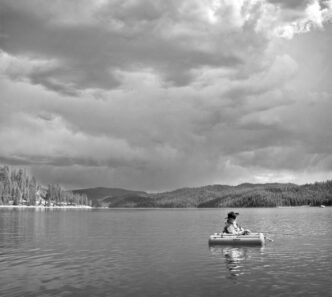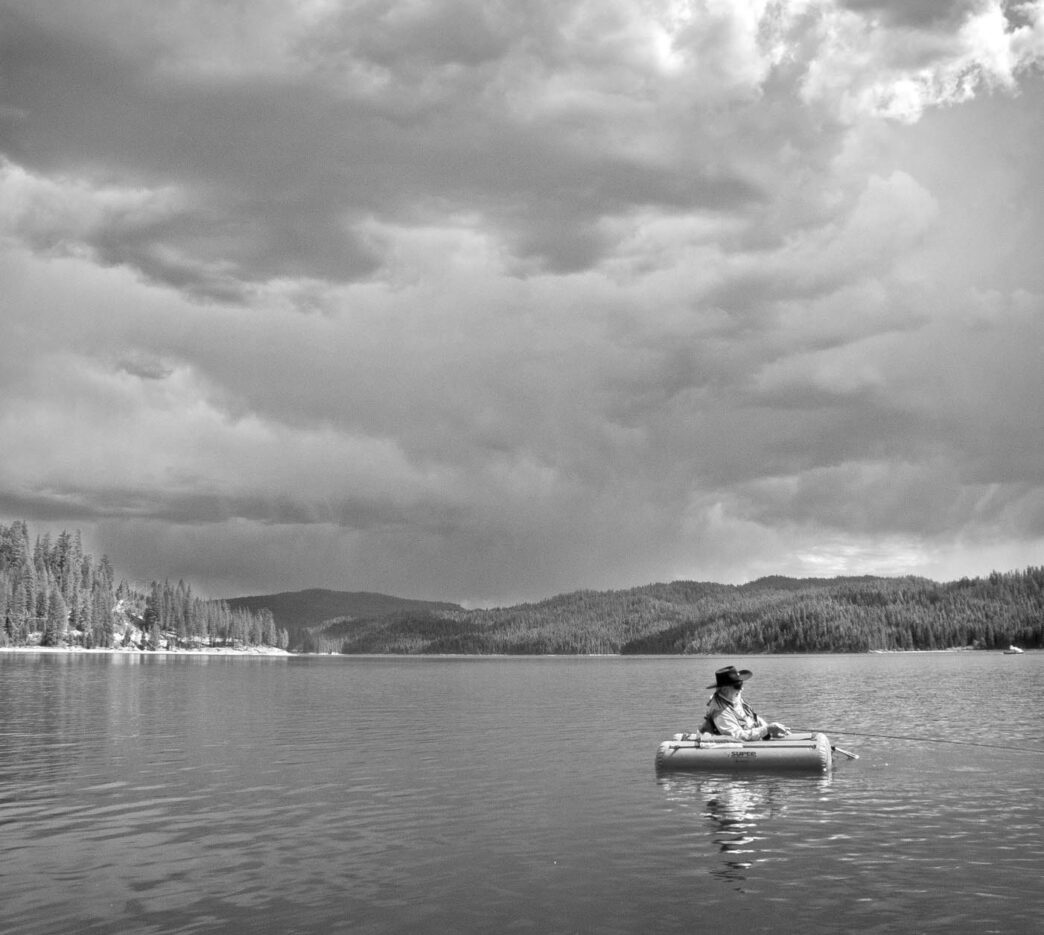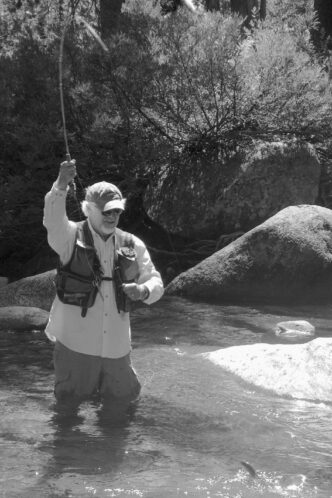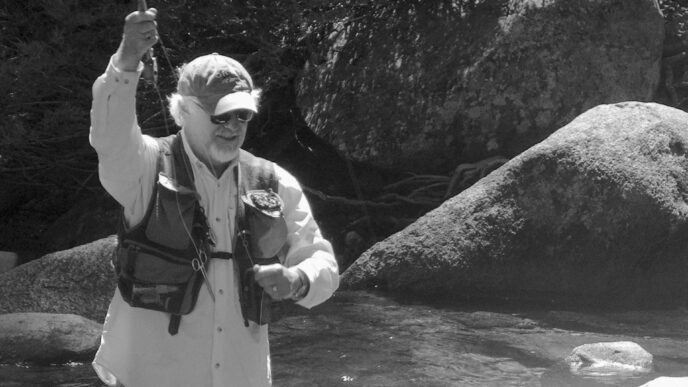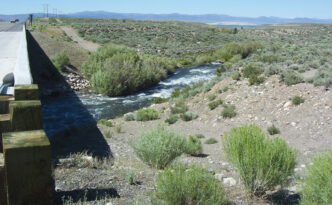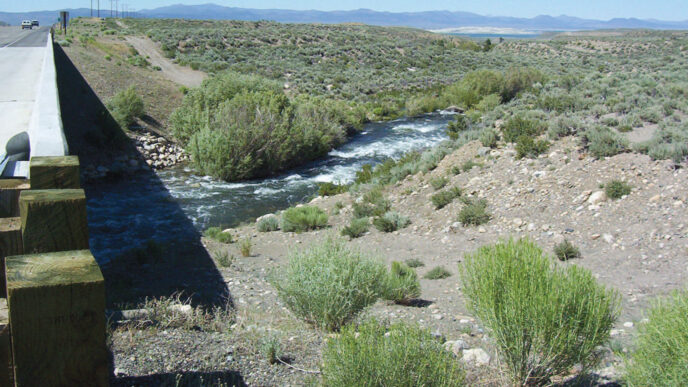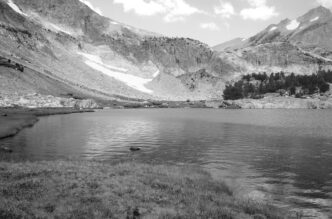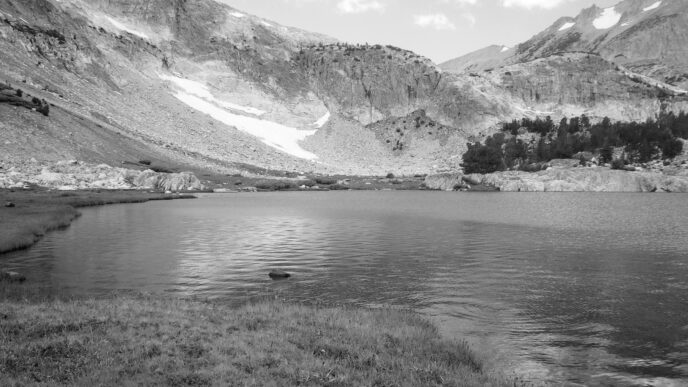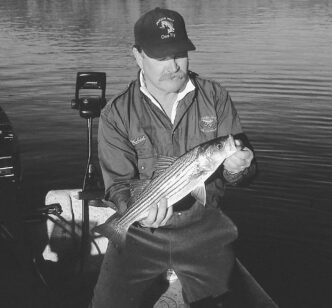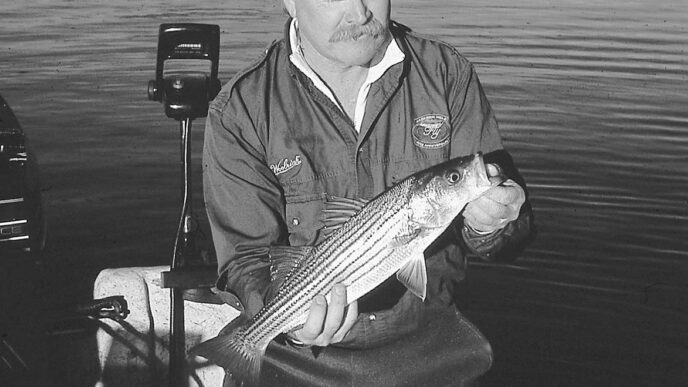A Great (and Quieter) Alternative to Lake Almanor
Butt Valley Reservoir is like that old Rodney Dangerfield joke: It don’t get no respect. It’s just four miles from its popular big brother, Lake Almanor, but comparatively few flyline anglers ply its waters. Yet it holds huge trout, a thriving smallmouth bass population, and boasts a great midsummer Hexagenia hatch.
Access is limited, but what exists isn’t inadequate. The reservoir is popular with campers, and the two campgrounds, which between them have about 100 sites, are crowded most of the summer. And yes, there are anglers, including some fly fishers, but never so many there isn’t room for a few more.
The only restriction on the lake is no water-skiing, which makes sense because a lot of the five-mile-long PG&E reservoir is studded with stumps, some of them above water, but others lurking just a few inches beneath the surface, ready to do serious damage to a speeding boat. For float tubers, that’s a big plus — Lake Almanor can be like Disneyland, with speeding boats, jet skis, water skiers, and parasailers making even that huge hunk of water feel mobbed.
One of the reasons Butt Valley Reservoir hasn’t caught on with fly fishers is that in 1996 it was emptied for repair work on the dam, and it took some years for the impoundment to refill and for the fish and bug populations to regenerate. Although the angling now it is as good as it ever was, the word doesn’t seem to have gotten out to the California fly-fishing community.
Getting to the Water
With limited access, how-to and where-to information is important. First, getting to Butt Valley is easy: There’s a clearly signed turnoff to the south from Highway 89, which parallels the western shore of Lake Almanor. The turnoff is about halfway along the lake and is a two-lane, paved road all the way to the reservoir, where it turns to gravel.
The first access to the water actually is about half a mile before the road reaches the lake, where an unmarked gravel road turns off to the right and goes to the PG&E powerhouse at the upper end of the lake. It crosses Butt Creek, and just before the powerhouse is a small area where anglers can park and walk down a steep, unimproved trail to the water. At certain times of the year, when the powerhouse is operating, this can be the best water on Butt Valley Reservoir.
With the inflow coming through a large pipe from Lake Almanor, the water carries in pond smelt, which are chewed up as they go through the turbines and spewed out as chum. Trout, both rainbows and browns, gather at the powerhouse and gorge themselves, which is one of the reasons there are such big fish in Butt. Anglers can work this water, casting baitfish imitations with dark backs such as Clouser Minnows and Deceivers into the area below the powerhouse. There can be good fishing here even when the powerhouse is not operating, although it doesn’t attract as many lunkers.
The area is a peninsula, with the powerhouse water on one side and Butt Creek on the other. Plenty of fish, including some big trout, gather in Butt Creek. Anglers do best there when nymphing with an indicator.
Going on down the road, there is lake access at a green double gate just before Ponderosa Flat Campground. This is used as an overflow camping area when Ponderosa Flat fills up, but it usually is empty, and the gate locked. It is a short walk to the shore, where there is easy entry to the water for float tubers.
Ponderosa Flat Campground is on the lake, but it is a camping-only area with no provisions for day use (meaning you’ll need to camp in order to fish from here). It has 63 pull-in spots, along with toilets and water. There are no hookups. Both this campground and Cool Springs Campground up the road belong to PG&E and are fee areas, with a park manager to oversee each of them.
A better access is the Ray Adams Boat Launch and picnic area about a mile beyond the campground. There’s plenty of room for parking, and the fishing here is as good as anyplace, with a lot of weed growth just offshore. For those with boats or with strong legs and good lungs, the shoreline area directly across the lake from the boat ramp holds a lot of trout. It’s a long kick in a float tube, and Butt Valley Reservoir is big enough so that windy days can make the lake dangerous.
The second PG&E campground, Cool Springs, is one an a half miles beyond the boat ramp, but it, too, is only for camping. However, it is possible to leave your vehicle parked along the road and walk to the beach that borders the lake.
A little over a mile farther on there is an unmarked turnoff that’s tough to see — it is just a break in the brush lining the road. It is only a couple of hundred yards to the shore, and there is plenty of space for parking. This and a similar, but more visible dirt access 1.4 miles farther on are areas that the county, which maintains the road, tries to keep closed by building up dirt at the entrance. But the dirt berms inevitably are knocked down by locals using the areas. The second of these areas, which is easy to see, has signs prohibiting vehicles, camping, and fires.
The last entry point is just before the dam. Turn right where the road forks and keep your eyes open. This is a popular area for anglers targeting smallmouth bass.
Otherwise, it’s pretty much impossible to get to the water. The road stays well above the lake, and the drop to the water is usually too steep and brushy to climb down. There is no road access to the west side of the lake.
Butt Valley’s Fishery
So, how about the fishing?
First, there is an annual hatch of Hexagenia limbata, the huge yellow mayfly that draws anglers to Lake Almanor. Flyline types flock to Almanor for this event, but there is just as good a hatch (sometimes better) on Butt Valley Reservoir. This year, the Almanor Hex hatch was much later than usual, well into July before it really began, but by early July, the Butt Valley hatch was well underway. It was all along the eastern shore, and there was almost nobody fishing it. Both nights that I spent on the water, I didn’t see another float tuber and only a couple of boats passing in the distance.
The hatch begins when the sun goes down, or a little before — about 7:45 or 8:00 P.M., somewhat earlier than on Almanor. Up until you see the Hexes popping to the surface, shedding their shucks, and flying away, a big yellow nymph is the way to go. But once the hatch begins, the fish key on the surface, where they smash the Hexes that pause for a minute or so to dry their wings before taking to the air. A lot of the time, the bugs don’t make it on the first try, skittering across the water for a foot or so. That’s ding-dong dinner-bell time for trout.
Toss your Hex imitation out, let it sit for a bit, make a six-inch or eight-inch strip, and then pause. Don’t go light on your leader; use at least a 3X tippet. These are big fish, and they hit Hexes as if they haven’t had a decent meal in weeks. A lot of anglers toss their fly to fish rising around them, but I’ve had much better luck by just casting it out and giving it that pause-strip-pause action. After all, the fish are everywhere, cruising and looking, and just because they took a Hex in one place doesn’t mean they are still there. Your fly isn’t on the water when you are casting.
There are many Hex imitations around for both nymphs and dries, but I favor those designed by Tom Maumoynier, owner of the Lake Almanor Fly Fishing Company shop in Chester, the town at the northern end of Lake Almanor. This shop also is the place to go for any information you need on where, when, and how to fish Butt Valley Reservoir. Tom is an accurate source of such information and has a wellstocked fly-fishing store that has been open for several years.
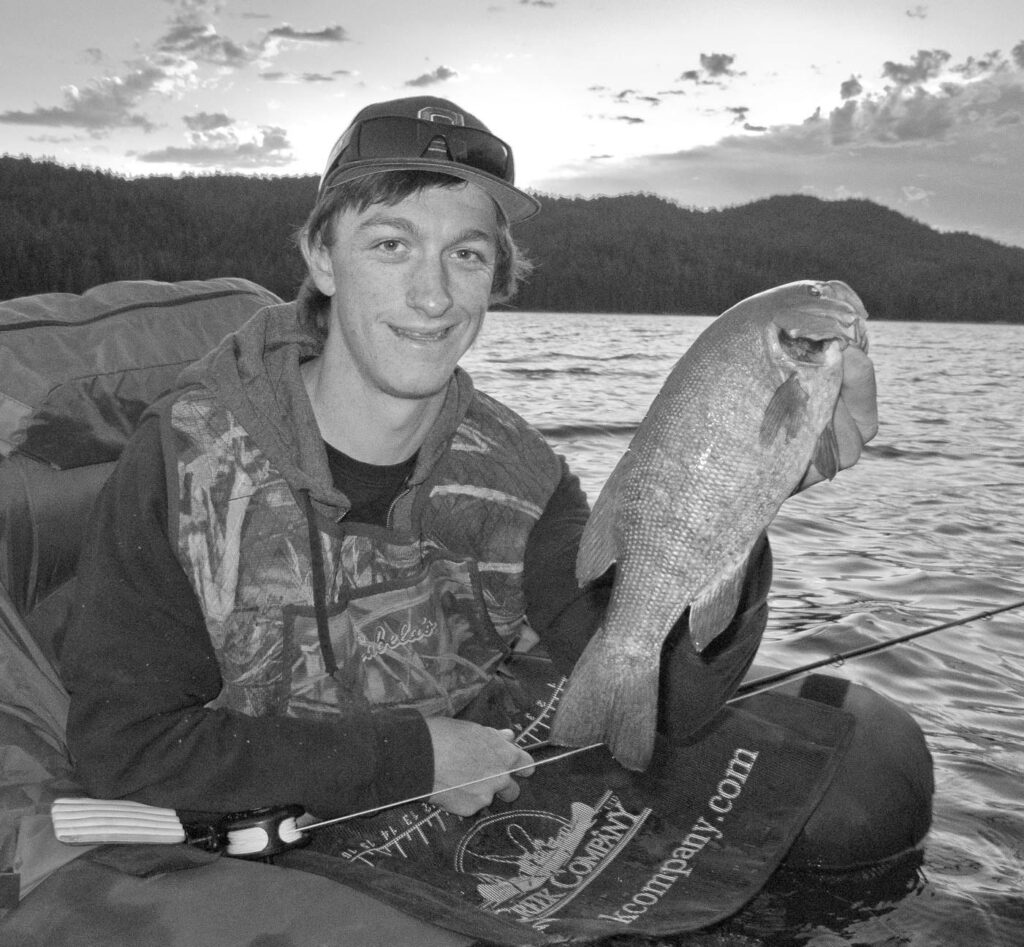
The big rainbows and browns, running into double-digit weights, are there all year. Apart from the powerhouse outlet and the Hex hatch, it just is a matter of finding them. There is a lot of weed growth up to a couple of hundred feet offshore, and that means plenty of food.
Maumoynier notes that the reservoir’s trout also feed heavily on the pond smelt that inhabit the lake, so Clouser Minnow or Deceiver imitations with dark backs in about size 8 or 10 can be effective. There’s also winter fishing, but Butt Valley is more than 4,100 feet above sea level and can be cold, windy, and snowy. If you do brave the elements, and the road to Butt Valley is open, midges are the most popular fish food during that time.
There’s more than trout fishing — smallmouth bass are abundant in many areas of the lake. Along the shore described above, they tend to gather around and in the many weed beds, so running a minnow imitation through the area draws fish. Maumoynier says they also love crayfish, so that’s another fly worth trying.
The big-trout reputation of Butt Valley Reservoir, usually called Butt Lake by locals, is well earned. Years ago, a 25pound rainbow was caught there and ended up mounted and on the wall of a local store. That record may not be matched, but there are plenty of fish in the 10-to15-pound range. Maumoynier’s personal best is a 12-pound, four-ounce ’bow.
It is hard to say that fishing at Butt Valley is better than at Lake Almanor, but Almanor is much more of a tourist and vacation destination. No matter where you go on Almanor, there are boats, jet skis, and other anglers. Even during the Hex hatch, fished late in the day, fly fishers are seldom without company. At popular areas, such as the boat ramp at the southwestern end of the lake, there usually are dozens of float tubers and boaters trying for the big ones.
Just four miles away, you’ll find a fine alternative.
If You Go…
The Lale Almanor Fly Fishing Company is a good source of up-to-date information. It is located at 181 Main Street in Chester — a new location. The phone is (530) 258-3944, their e-mail is flyfishing@frontiernet.net, and their Web site is www.almanorflyfishing.com. It is a full-service fly shop that also offers guide service.
Ayoob’s Sports, at 201 Main Street in Chester, also has some fly-fishing gear. For lodging and other information, try the Chester–Lake Almanor Chamber of Commerce at 529 Main Street in Chester; phone (800) 350-4838 or (530) 2582426. Their Web site is www.lakealmanorarea.com.
Don’t go light on your gear. A 5-weight rod should suffice, and both sinking and floating lines can be used. There’s always a chance of a really big trout, so fish 4X or even 3X leaders, particularly during the Hex hatch. These fish aren’t leader shy, even when fishing a dry. The usual mayfly, caddisfly, and damselfly imitations, such as a Pheasant Tail, Hare’s Ear, or Prince Nymph work well, but so do Woolly Buggers, Jay Fair Specials, and Wiggle-Tail Damsels. There can be afternoon or evening hatches of both mayflies and caddisflies, but most of the action is on nymphs.
Because the trout and smallmouth bass key on the little pond smelt that inhabit the lake, minnow imitations are effective. Clouser Minnows or Deceivers with dark backs are imitative patterns, and the smallies also love crawdads.
Bill Sunderland



